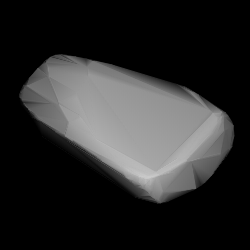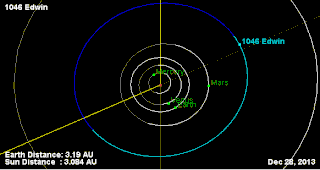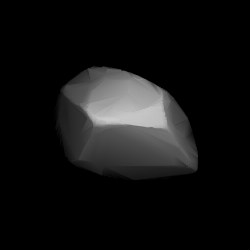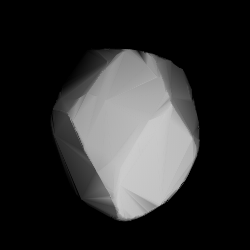
220 Stephania is a dark background asteroid from the inner regions of the asteroid belt, approximately 32 km (20 mi) in diameter. It was discovered on 19 May 1881, by Austrian astronomer Johann Palisa at the Vienna Observatory. The C-type asteroid has a rotation period of 18.2 hours. It was named after Princess Stéphanie of Belgium.
1108 Demeter, provisional designation 1929 KA, is a dark asteroid from the inner regions of the asteroid belt, approximately 27 kilometers in diameter. It was discovered on 31 May 1929, by German astronomer Karl Reinmuth at the Heidelberg-Königstuhl State Observatory near Heidelberg, Germany. The asteroid was named after Demeter, the Greek goddess of fruitful soil and agriculture. It has a rotation period of 9.846 hours.

1130 Skuld, provisional designation 1929 RC, is a stony Florian asteroid from the inner regions of the asteroid belt, approximately 10 kilometers in diameter. It was named after Skuld from Norse mythology.
Arago, provisional designation 1923 OT, is a dark asteroid from the outer regions of the asteroid belt, approximately 55 kilometers in diameter. It was discovered on 5 September 1923, by Russian astronomer Sergey Belyavsky at the Simeiz Observatory on the Crimean peninsula. The asteroid was named after French mathematician François Arago.

1069 Planckia, provisional designation 1927 BC, is a background asteroid from the outer regions of the asteroid belt, approximately 39 kilometers in diameter. It was discovered on 28 January 1927, by astronomer Max Wolf at the Heidelberg-Königstuhl State Observatory in Germany. The asteroid was named after German physicist Max Planck.

1046 Edwin, provisional designation 1924 UA, is a background asteroid from the outer regions of the asteroid belt, approximately 30 kilometers kilometers in diameter. It was discovered on 1 December 1924, by Belgian–American astronomer George Van Biesbroeck at the Yerkes Observatory in Wisconsin, United States, who named it after his son, Edwin Van Biesbroeck. The potentially metallic asteroid has a short rotation period of 5.29 hours.
1109 Tata, provisional designation 1929 CU, is a dark Hygiean asteroid from the outer regions of the asteroid belt, approximately 69 kilometers in diameter. It was discovered on 5 February 1929, by German astronomer Karl Reinmuth at the Heidelberg-Königstuhl State Observatory in Germany. The meaning of the asteroids's name is unknown.

1127 Mimi is a dark background asteroid from the central regions of the asteroid belt. It was discovered on 13 January 1929, by Belgian astronomer Sylvain Arend at the Royal Observatory of Belgium in Uccle. The carbonaceous C-type asteroids (CX) has a rotation period of 12.7 hours and measures approximately 47 kilometers in diameter. Through a glitch in the naming process, the asteroid received the name "Mimi" instead of "Robelmonte" as originally intended by the discoverer.
1152 Pawona, provisional designation 1930 AD, is a stony Vestian asteroid from the inner regions of the asteroid belt, approximately 16 kilometers in diameter. Discovered by Karl Reinmuth at Heidelberg Observatory in 1930, the asteroid was named in honor of astronomers Johann Palisa and Max Wolf.
1815 Beethoven, provisional designation 1932 CE1, is a carbonaceous background asteroid from the outer regions of the asteroid belt, approximately 30 kilometers (19 miles) in diameter. It was discovered on 27 January 1932, by German astronomer Karl Reinmuth at the Heidelberg Observatory. The uncommon F-type asteroid seems to have a long rotation period of 54 hours (tentative). It was named after Ludwig van Beethoven.
1295 Deflotte, provisional designation 1933 WD, is a carbonaceous asteroid from the outer regions of the asteroid belt, approximately 48 kilometers in diameter. It was discovered on 25 November 1933, by French astronomer Louis Boyer at the Algiers Observatory in Algeria, North Africa. The asteroid was named after the discoverer's nephew.
1421 Esperanto, provisional designation 1936 FQ, is a dark background asteroid from the outer regions of the asteroid belt, approximately 55 kilometers in diameter. It was discovered on 18 March 1936, by Finnish astronomer Yrjö Väisälä at the Iso-Heikkilä Observatory in Turku, southwest Finland. The presumed C-type asteroid has a rotation period of nearly 22 hours. It was named for the artificial language Esperanto.
1267 Geertruida, provisional designation 1930 HD, is a carbonaceous background asteroid from the inner regions of the asteroid belt, approximately 20 kilometers in diameter. Discovered by astronomer Hendrik van Gent at Johannesburg Observatory in 1930, the asteroid was later named after Geertruid Pels, sister of Dutch astronomer Gerrit Pels.
1200 Imperatrix is a carbonaceous Hygiean asteroid from the outer regions of the asteroid belt, approximately 40 kilometres (25 mi) in diameter. It was discovered by German astronomer Karl Reinmuth at the Heidelberg-Königstuhl State Observatory on 14 September 1931. The asteroid was named after the Latin word for empress.

1281 Jeanne is a dark asteroid from the background population of the intermediate asteroid belt. It was discovered on 25 August 1933, by astronomer Sylvain Arend at the Royal Observatory of Belgium in Uccle, who named it after his daughter, Jeanne. The likely P-type asteroid has a rotation period of 15.2 hours and measures approximately 22 kilometers in diameter.

1356 Nyanza, provisional designation 1935 JH, is a dark asteroid from the background population of the outer asteroid belt, approximately 63 kilometers in diameter. It was discovered on 3 May 1935, by South-African astronomer Cyril Jackson at the Union Observatory in Johannesburg. The asteroid was named for the former Nyanza Province in Kenya, Africa.
1243 Pamela, provisional designation 1932 JE, is a carbonaceous background asteroid from the outer regions of the asteroid belt, approximately 70 kilometers in diameter. It was discovered on 7 May 1932, by South African astronomer Cyril Jackson at the Union Observatory in Johnannesburg. The asteroid was named for Pamela Jackson, daughter of the discoverer.
1190 Pelagia, provisional designation 1930 SL, is a dark Nysian asteroid from the inner regions of the asteroid belt, approximately 17 kilometers in diameter. It was discovered on 20 September 1930, by Soviet–Georgian astronomer Grigory Neujmin at the Simeiz Observatory on the Crimean peninsula. The asteroid was named after astronomer Pelageya Shajn.
1258 Sicilia, provisional designation 1932 PG, is a dark background asteroid from the outer regions of the asteroid belt, approximately 44 kilometers in diameter. It was discovered on 8 August 1932, by astronomer Karl Reinmuth at the Heidelberg-Königstuhl State Observatory in southwest Germany. The asteroid was named after the Italian island of Sicily.
1447 Utra, provisional designation 1938 BB, is a stony asteroid, slow rotator and suspected tumbler from the central region of the asteroid belt, approximately 12 kilometers in diameter. It was discovered on 26 January 1938, by Finnish astronomer Yrjö Väisälä at Turku Observatory in Southwest Finland. The asteroid was named for the Finnish town of Utra.







